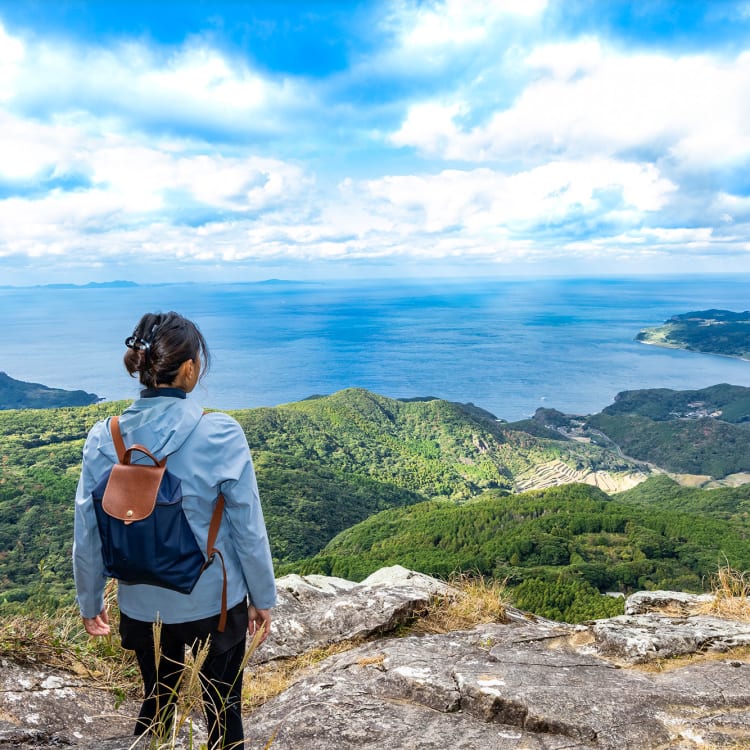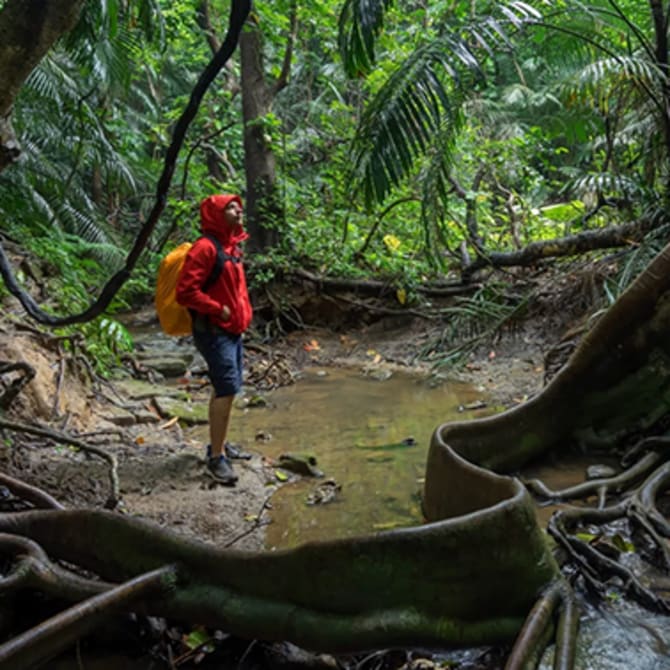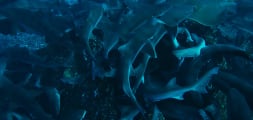
Travel Logs A Journey Through Hirado Island Discovering Hidden Gems in Japan’s Historic Gateway to the West
The island of Hirado, tucked in the northwest corner of Nagasaki, bears a fascinating legacy. In the 16th century Hirado became the first port in Japan to welcome European traders and you can still spot traces of Dutch and Portuguese influences in the local landscape and cuisine. Some of the more secluded parts of the island were once a refuge for secret Christian converts who continued to practice their faith throughout the country’s ban on the religion. With its dramatic coastlines, cerulean waters, and lush forests, the island is also part of Saikai National Park. Its rich history and picturesque vistas make Hirado the perfect backdrop for a plethora of activities, from hiking and cycling to fishing and museum-hopping.
Day 1

Hirado Ohashi Bridge.
An enormous red bridge marks the entryway into Hirado Island from mainland Kyushu. As we land on the island, two of its most recognizable landmarks come into view—the stately Hirado Castle and the sage-green spires of St. Francis Xavier Memorial Church—reminding us that this was once where Eastern and Western cultures converged. That legacy is still infused throughout the townscape, with traditional samurai residences and rustic temples standing alongside gothic-style buildings. Not long after stepping foot in Hirado, we hopped on our rental bicycles, eager to explore the town’s historic streets and alleyways.

Downtown Hirado.

View of church juxtaposed against temple buildings.
The first stop on our itinerary was the crowning gem of the island, Hirado Castle. Originally built in 1599, this hilltop castle was destroyed and rebuilt multiple times. “The castle we see now is a restoration with some of the original features still in place,” says our guide. We ventured up to the castle tower to be rewarded with gorgeous views of the port and the deep blue waters of Hirado Strait.

Hirado Castle.
Hirado Castle Stay

Visitors hoping to make their time in Hirado even more special can opt to stay like royalty in the Kaiju Yagura tower. Set within the castle grounds, this luxurious accommodation blends modern comforts with an ornately designed interior. Guests are treated to traditional performances and delectable meals prepared by a personal chef.

Hirado Dutch Trading Post.
Located not too far from Hirado Castle is the former Hirado Dutch Trading Post, which is now a museum. “It was constructed in 1639 but destroyed shortly after, so the building that stands now is a faithful reconstruction using detailed records from the Netherlands,” explains our guide. Inside we encounter fascinating pieces that give us a glimpse into Hirado’s ties with the Dutch such as wooden statues, paintings, and armor.

Inside the Dutch Trading Post Museum.
To further immerse ourselves in the local history, we paid a visit to the Matsura Historical Museum which houses over 30,000 precious relics. The building itself is culturally significant as it was once the private residence of the Matsura Clan, which ruled over Hirado for over 800 years. After admiring the incredible collection of ancient scrolls and paintings, we stopped to relish green tea and traditional sweets at the Kanuntei Teahouse, set within the museum grounds. This charming building is nestled in a garden of cherry blossom and maple trees, making it perfect for a quiet moment of contemplation.

Kanuntei Teahouse.

Green tea and traditional sweets served at Kanuntei Teahouse.
Day 2
We kicked off the second day of our visit by mounting our bicycles and making our way to Hirado’s highest point, Mt. Yasumandake. After winding through roads hemmed by dense evergreen forests, we found ourselves in Kawachi Pass—an open grassy expanse that offers sweeping views of the Genkai Sea and clusters of tiny islands. Our guide pointed out the islands of Iki and Tsushima visible far off in the distance, as well as Nakaenoshima, an uninhabited island that was venerated by ‘Hidden Christians’ who were persecuted during the 17th century.

Kawachi Pass.
An ancient torii shrine marks Mt. Yasumandake’s trailhead. The 536-meter peak is steeped in history—for centuries, it was a sacred site for Buddhists, Shintoists, as well as the Hidden Christians. To this day, it is strewn with stone monuments, shrines, and statues. The trail to the summit is paved with cobblestones, which were walked barefoot by pilgrims of the past.

Mt. Yasumandake trailhead.
As we climbed up a lush forest of evergreen oak and moss, we were serenaded by bird call and kept our eyes peeled for a local species of the endangered tailed cupid butterfly which can be recognized by its delicate violet-colored wings. On the way, our guide showed us the ruins of an 8th-century temple as well as stone monuments hallowed by Hidden Christians.

Hiking up Mt. Yasumandake.
Just off the summit is a viewpoint where you can observe the western shores of the island, along with Kasuga Village and the neighboring Ikitsuki Island. The mountain is also great for birdwatching, as you can spot migratory birds traveling between Japan and the Korean Peninsula depending on the time of the year.

Viewpoint at Mt. Yasumandake summit.
After admiring the spectacular views, we began our descent to Kasuga Village. Surrounded by terraced rice paddies, this remote spot was once a refuge for a community of Hidden Christians. “Mt. Yasumandake, Nakaenoshima Island, and Kasuga Village are all Hidden Christian sites that make up a World Heritage Site,” says our guide.

View from Maruoyama Hill in Kasuga Village.
Once we were at the village, we climbed up to Mt. Maruo to admire the beautiful rice paddies. The area is incredibly quiet and retains an idyllic charm, making us feel like we had stepped back in time. We then stopped at the local tourist center to unwind, chat with locals and enjoy a delicious boxed lunch prepared with locally-grown ingredients before making our way back to our accommodation.

Chatting with locals at Kasuga Village.

Boxed lunch prepared with local ingredients.
Day 3
We were up bright and early on Day 3 to join a fishing crew on their boat—it was a rare and unique opportunity to watch fishers in action. We embarked on our journey well before sunrise at Shiraishi Fishing Port, located on the west side of the island.

Fishing expedition.
Being on a fishing boat was an exhilarating experience; you can soak in the refreshing sea breeze and first rays of the morning sun accompanied by the excited calls of the fishing crew and hungry seagulls. The local fishers here use a set-net fishing method. We were lucky to be able to join in on the action, helping them reel in huge catches of horse mackerel, yellowtail, and flounder.

Blowfish.
After returning to shore, we were treated to a delicious and hearty breakfast that included sashimi and grilled fish prepared from the fresh catch, as well as rice and miso soup.

Fresh catch for breakfast.
Since we had a long day of cycling ahead, we prepared our own lunch boxes packed with oshizushi—rice cakes stuffed with fillings of our choice. We went with a mix of chopped mushrooms, carrots, and burdock. In Hirado, oshizushi is normally eaten on special occasions, so they are prepared in auspicious shapes like the cherry blossom flower.

Making oshizushi.

Oshizushi.
From the fishing port, we hopped on our bicycles and traversed the pastel blue bridge that connects Hirado to Ikitsuki Island. The plan was to cycle a loop around the island along a route nicknamed the Ikitsuki Sunset Way.

Ikitsuki Island.
The area is known for its dramatic stretch of coastline known as the Shiodawara Cliffs. Shaped by the pounding waves of the Genkai Sea, these formations have a striking honey-comb like appearance.

Shiodawara Cliffs.
Obae Lighthouse sits on a steep cliff on the northernmost tip of the island. We decided to stop there to savor the oshizushi we had made earlier and soak in the stunning seascape.

Cycling along Ikitsuki Sunset Way.
As we made our way back toward Hirado, we stopped by Daifukuya—a locally-beloved dessert shop—to refuel. Founded more than 70 years ago, this retro establishment is known for their decadent Nagasaki-style milkshakes prepared with shaved ice and condensed milk. As the day neared its end, we were rewarded with a beautiful sunset by the southern tip of Ikitsuki Island.

Nagasaki-style milkshake at Daifukuya.

Sunset at the southern tip of Ikitsuki Island.
Day 4
On our last day in Hirado, we took a deep dive into the quintessential Hirado confection, the casdoce. Originally from Portugal, this delectable sweet treat is prepared by dipping pieces of castella sponge cake in egg yolk and boiling it in sugar. We got a chance to try it ourselves at the factory of Tsutaya, a confectioner that has been around since the early 1500s. “Casdoce was once exclusively made for royalty,” a staff member told us. Preparing casdoce is quick and fun, and we were invited to sample our piping hot creations once they were ready.

Making casdoce.

Freshly-made casdoce.
Tsutaya also has a retail shop in central Hirado where you can purchase beautifully packed boxes of casdoce as souvenirs, or treat yourself to castella-infused ice cream on a hot day.

Castella ice-cream at Tsutaya.
In Hirado, you can also find a variety of indoor activities if you get unlucky with the weather. We joined a stencil-dyeing workshop to craft a memento of our trip. Pick a souvenir of your choice—such as a t-shirt or tote bag—and paint it using one of the many pre-prepared stencil designs.

Stencil-dyeing workshop.

Stencil-dyed tote.
Steeped in European influences, Hirado offers a glimpse into a different side of Japan. Whether you are looking to immerse yourself in the outdoors, delve into history, or try your hand at something new, this picturesque port town offers something for every kind of traveler.




































































